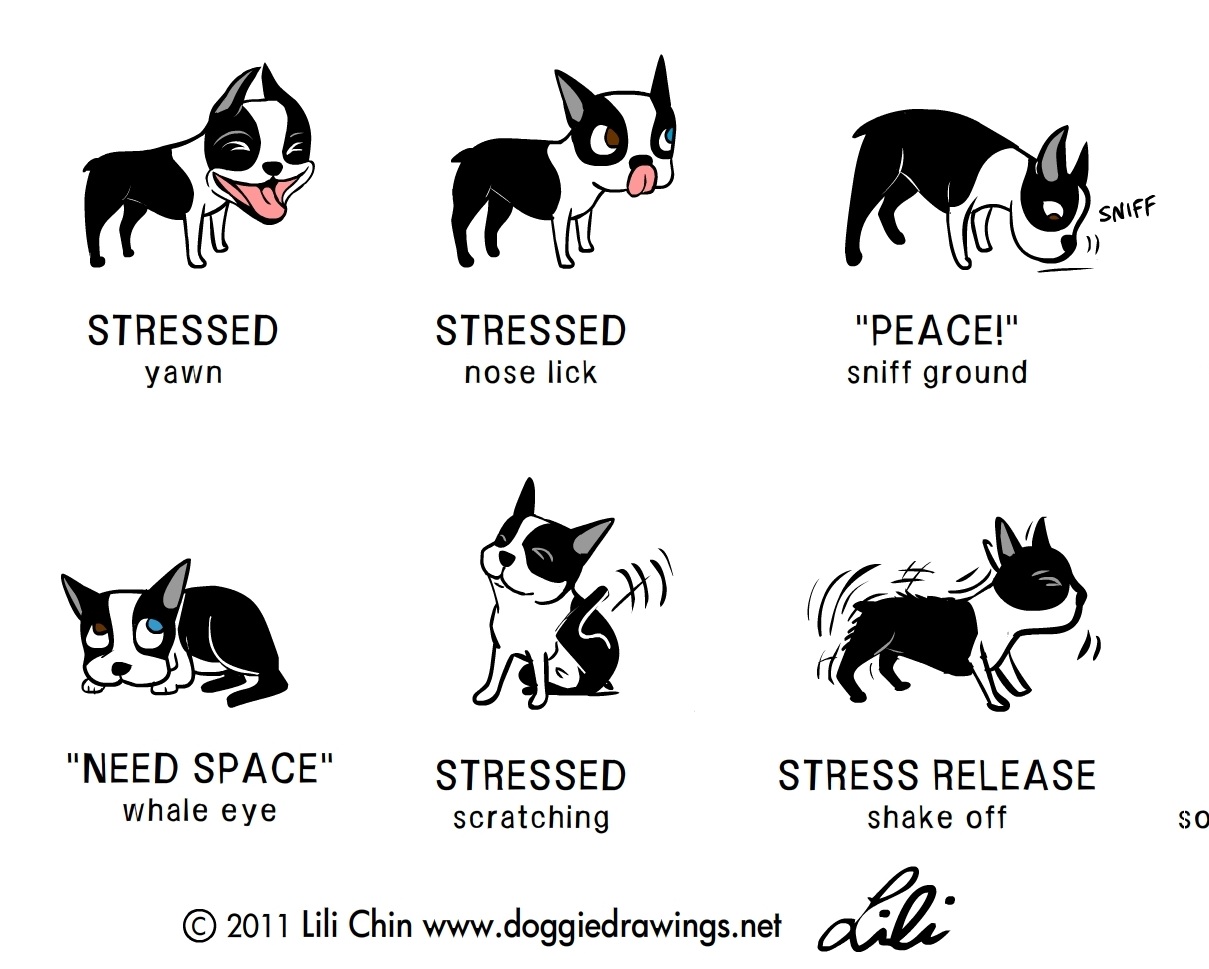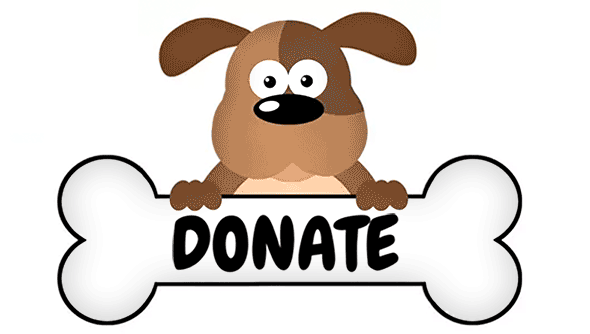 Fearful / Shy
Fearful / Shy
Dogs experience anxiety for a number of reasons. This article will help you recognize your dog’s stress signals and provide you with several strategies for helping your dog feel safe.
How to Recognize Your Dog’s Stress Signals
If you know what to watch for, you will be able to see when your dog is becoming overwhelmed. Your dog may exhibit some of these signs: a tucked tail; lip licking; yawning (when not tired); head turned away; hiding behind you or under a chair or table; lowering of his head or cowering; shaking off as if wet; a half moon eye (white showing around the iris); whining; or pacing.
A more subtle sign of stress is when a dog becomes quiet and is doing much less than usual. The dog may look relaxed, but, in fact, has ‘shut down’ and become withdrawn.
Remember that fear can be expressed in ways that seem to be polar opposites. Some dogs will be timid and try to avoid or leave the situation. This is the dog that hides behind his person or stays on the periphery, rather than face what he’s afraid of. However, the dog that seems aggressive is generally afraid, too. He just uses a different tactic. By growling and lunging, he is able to keep other dogs or people away. Some dogs will even growl at stationary objects with the hope that they will move away as well.
There is a range of fear responses from a little timid to the overwhelming anxiety experienced by a puppy mill dog. Since puppy mill dogs have spent their lives only in kennels, these dogs are spooked by everyday life – wearing a collar and leash, hearing the sound of appliances, climbing stairs, going to the bathroom outside, etc.
What Is Your Dog Afraid Of?
Once you learn to recognize your dog’s discomfort, observe what triggers your dog’s fears. Your dog may be afraid of any number of common occurrences: a vacuum, flying leaves, holiday decorations, or an alarm. Many dogs are afraid of children, men, or strangers. Children run around, are unpredictable, and have high-pitched voices. Men tend to approach dogs head-on. Strangers often lean over dogs and pat them on their heads to say “hello”.
It is common to assume that fear comes from some sort of abuse. While sometimes that is the case, most fearful dogs simply weren’t exposed to other dogs, people, and environments as a puppy, so they fear the unusual or unexpected. A sensitive dog could be fine with men, but not with men with hats or glasses or beards.
Helping your Dog Feel Safe
With a fearful dog, your #1 priority should be helping your dog feel safe. If your dog is new, don’t overwhelm him with activities or crowds. Avoid public events or family gatherings. Dog parks, schools, school bus stops, and shopping areas can all be particularly frightening to fearful dogs.
Notice where in your home your dog goes when he’s afraid, and make sure that he can get there easily. This could be an open crate or room, under the stairs or under a table. If your dog is afraid of people, it’s kinder to let him go to his safe place before guests arrive. NOTE: During a thunderstorm, some dogs prefer a bathroom.
If a person is afraid of heights, he won’t get over it by being scolded or punished. Likewise, it is crucial not to punish or scold your dog for showing fear. An anxious dog may dribble urine when afraid (“submissive peeing”), damage your doors and windows trying to escape, whine or bark. Others will growl at people or dogs to keep them away. You are trying to build trust, and that’s not something you can do using choke, prong, electronic collars, spray bottles, or coin shakers.
Building your dog’s confidence may also help. You can do this by using positive training either at home or, if your dog is ready, in a class setting. Some activities, such as Nose Work, can give your dog a job that he enjoys. Tellington Touch (TTouch) can help calm your dog’s nervous system and also includes confidence building exercises.
Counter-Conditioning and Desensitization
A positive trainer can develop a plan for your dog that will do two things:
- Help your dog associate what he fears with something good
- Work from a low level to a higher level of intensity (generally distance or volume)
Don’t rush this process. It can take weeks to months; and even then, although your dog can improve greatly, he may never be completely comfortable with what scares him.
Let’s use the example of a dog afraid of a vacuum cleaner. You need to put your dog on leash for these exercises. You start with the vacuum cleaner off, but within sight of your dog. You feed your dog multiple small treats from a distance at which your dog can see the vacuum, but is not overly disturbed by it. When you turn to walk away, you stop the treats. You repeat the same process in gradual increments. You turn the vacuum on for 3 seconds, start treats, turn off the vacuum, and stop treats. You move the vacuum slightly, and go through the same process. You move it more, etc. If, at any time your dog shows signs of anxiety, you are moving too fast and need to either increase your distance or move the vacuum less. As your dog shows that he’s more comfortable, you can begin decreasing the distance and start at the beginning again. You are changing your dog’s response from “that thing is scary” to “good things happen when the vacuum is working.” You are getting your dog used to the vacuum by starting with less noise and less movement and then gradually increasing them.
If your dog is scared of a sound, you often can’t control when that sound occurs or how loud the sound will be. In these cases, you need a way to control what’s happening. Lucky you! You can buy CD’s or phone apps that mimic thunder, fireworks, truck noises, baby cries, and almost anything else. You then play the CD at a low volume, while feeding your dog treats only when the CD is playing. As your dog’s comfort level increases, you can gradually turn up the volume. Keep in mind, though, that it may not be the sound alone that spooks your dog. With thunderstorms, for example, there is not only the sound of thunder to contend with, but also the change in barometric pressure, darkening sky, wind, lightning, and static in the air. Think outside the box. When you know a storm is expected, close the blinds; rub your dog’s body with Bounce (hey! It could work); distract your dog with a favorite game or training; turn on classical music or a white noise machine; and make the bathroom (bathrooms have grounded plumbing) available to your dog. Gentle, constant pressure (swaddling) a baby has been used for years to calm babies. The same holds true for animals. Some dogs respond well to thundershirts (www.thundershirt.com).
How a Veterinarian Can Help
Check with your veterinarian to rule out medical causes, especially if you have noticed a change in behavior or your dog doesn’t like being touched in an area he didn’t mind before. A dog that is hurt or has an undiagnosed illness will be less tolerant and want others to stay away. Remember that discomfort can be displayed as shyness or aggression. Some symptoms should be checked for medical causes as well. If your dog has changed his potty behavior, it may not be anxiety. It could be a urinary tract infection or bladder stones.
Some dogs will benefit from medication to supplement work with a trainer. You may be someone who wants to avoid medication at all costs, but think of it this way: Your dog doesn’t like being anxious. So, if there’s anything you can do, including medication, that can help, you will be doing your dog a favor.
A Comprehensive Approach
It should be clear, by now, that helping your fearful dog often requires a combination of methods:
- Manage your dog’s environment to reduce your dog’s fears and build trust
- Work with a positive trainer to change your dog’s association with what he fears and the intensity that he can tolerate (distance or volume)
- Consider medication and explore alternative remedies to reduce your dog’s anxiety and aid your dog’s progress
- Find ways to build your dog’s confidence.
Key Points to Remember
- Check with a veterinarian to rule out medical conditions.
- Don’t put your dog in situations he can’t handle. Exposing your dog to something that makes him anxious won’t help him get over his anxiety.
- Learn how to read your dog’s body language, so you can tell when he is in over his head and needs to get away.Have a safe place in your home where your dog can go to chill out – a crate, a room, or under a stairway or table – where your dog won’t be bothered.
- Don’t let strangers, other dogs, children, or even family members crowd your dog.
- Meet with a positive trainer to develop a behavior modification plan. Counter-conditioning and desensitization can help your dog immensely, as long as you don’t rush the process.
- Be willing to consider medication if your dog “needs” it.
- Don’t forget that there are activities that can help build your dog’s confidence – whether you do them at home or in a controlled, positive class setting.
Resources
A Guide to Living with & Training a Fearful Dog, Debbie Jacobs The website where you order this book, www.fearfuldogs.com, has a wealth of information.
www.facebook.com/groups/fearfuldogs/ – a Facebook group for people living or working with fearful, shy, timid or anxious dogs
The Cautious Canine-How to Help Dogs Conquer Their Fears, Patricia McConnell
Help for the Fearful Dog: A Step by Step Guide to Helping Your Dog Conquer His Fears, Nicole Wilde
Check our articles on Reactive Dogs and Separation Anxiety, if these are your dog’s issues.
Still Need Help?
Contact Your Dog’s Friend at [email protected] or (301)983-5913 for advice and referrals or check out our list of recommended trainers and behaviorists.
Your Dog’s Friend is a nonprofit 501(c)(3) organization working to improve dogs’ lives, reduce problem behaviors, and keep dogs out of shelters, by educating and supporting their humans.
This material is not intended to be a substitute for professional help when dealing with dogs with intense or potentially dangerous behavior issues. Consult a positive reinforcement trainer or veterinary behaviorist for professional assessment, guidance, and support.




